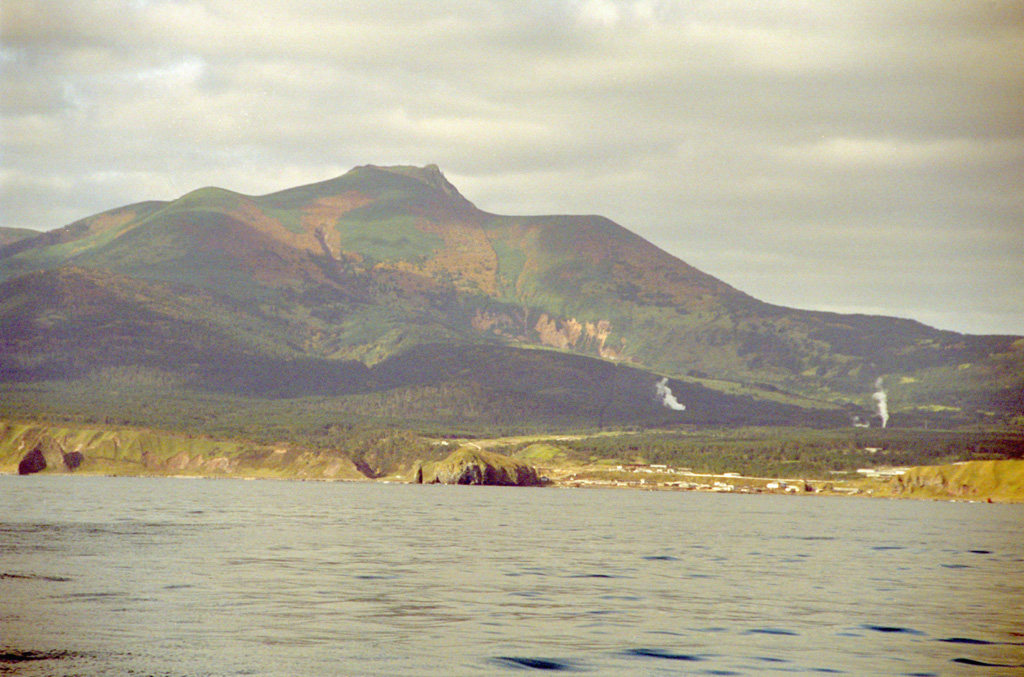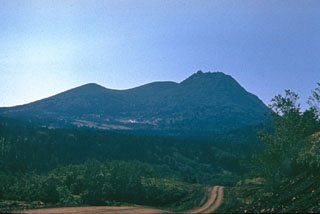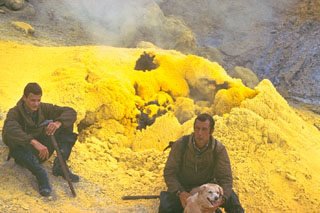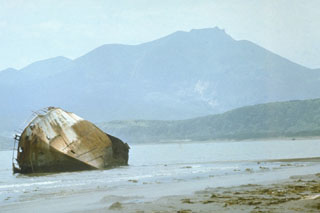Due to the US Government shutdown, the Smithsonian is temporarily closed. The Global Volcanism Program website will remain available but will not be monitored or updated. Status updates will be available on the Smithsonian homepage.



Earthquake swarm associated with geothermal production
A summit earthquake swarm with focal depths of <10 km was recorded 4-5 May 1987 (table 9-1). Epicenters were <15 km from Yuzhno-Kurilsk seismic station (12 km from the volcano). Repeated measurements 25-28 September in a borehole 10 km from the summit registered temperatures 4°C higher than in 1986 at a depth of 74 m. Temperatures increased 4-5°C in some hot springs on the E and S flanks. Fumaroles in the same area showed essentially no variation from 1986; vapor emitted under pressure had temperatures of 97-107°C. . . . the earthquakes seemed to be caused by exploitation of geothermal wells, used for heat production.
Information Contacts: G. Steinberg, Yuzhno-Sakhalinsk.
The Global Volcanism Program has no Weekly Reports available for Raususan [Mendeleev].
Reports are organized chronologically and indexed below by Month/Year (Publication Volume:Number), and include a one-line summary. Click on the index link or scroll down to read the reports.
Intense fumarolic and solfataric activity
In the explosive crater area on the volcano's E slope intense fumarolic and solfataric activity was occurring during a 6 November aerial survey.
Information Contacts: G. Steinberg and B. Piskunov, Yuzhno-Sakhalinsk.
Earthquake swarm associated with geothermal production
A summit earthquake swarm with focal depths of <10 km was recorded 4-5 May 1987 (table 9-1). Epicenters were <15 km from Yuzhno-Kurilsk seismic station (12 km from the volcano). Repeated measurements 25-28 September in a borehole 10 km from the summit registered temperatures 4°C higher than in 1986 at a depth of 74 m. Temperatures increased 4-5°C in some hot springs on the E and S flanks. Fumaroles in the same area showed essentially no variation from 1986; vapor emitted under pressure had temperatures of 97-107°C. . . . the earthquakes seemed to be caused by exploitation of geothermal wells, used for heat production.
Information Contacts: G. Steinberg, Yuzhno-Sakhalinsk.
|
|
||||||||||||||||||||||||||
There is data available for 2 confirmed eruptive periods.
[ 1900 ] Uncertain Eruption
| Episode 1 | Eruption (Explosive / Effusive) | ||||||||||||||
|---|---|---|---|---|---|---|---|---|---|---|---|---|---|---|
| 1900 - Unknown | Evidence from Unknown | |||||||||||||
|
List of 1 Events for Episode 1
|
||||||||||||||
1880 Confirmed Eruption (Explosive / Effusive) VEI: 1
| Episode 1 | Eruption (Explosive / Effusive) | NE solfatara field | ||||||||||||||||||
|---|---|---|---|---|---|---|---|---|---|---|---|---|---|---|---|---|---|---|---|
| 1880 - Unknown | Evidence from Observations: Reported | ||||||||||||||||||
|
List of 2 Events for Episode 1 at NE solfatara field
|
|||||||||||||||||||
2270 BCE ± 50 years Confirmed Eruption (Explosive / Effusive)
| Episode 1 | Eruption (Explosive / Effusive) | West side of central cone, KnIV-10 tephra | |||||||||||||||||||||||||||||||||
|---|---|---|---|---|---|---|---|---|---|---|---|---|---|---|---|---|---|---|---|---|---|---|---|---|---|---|---|---|---|---|---|---|---|---|
| 2270 BCE ± 50 years - Unknown | Evidence from Isotopic: 14C (uncalibrated) | |||||||||||||||||||||||||||||||||
|
List of 5 Events for Episode 1 at West side of central cone, KnIV-10 tephra
|
||||||||||||||||||||||||||||||||||
This compilation of synonyms and subsidiary features may not be comprehensive. Features are organized into four major categories: Cones, Craters, Domes, and Thermal Features. Synonyms of features appear indented below the primary name. In some cases additional feature type, elevation, or location details are provided.
Synonyms |
||||
| Louse | Rausu-dake | Rouse | Simanobori | Mendeleyev | Kunashiri-Rausu | Raususan | Mendeleev | ||||
Craters |
||||
| Feature Name | Feature Type | Elevation | Latitude | Longitude |
| Koraususan | Caldera | |||
Domes |
||||
| Feature Name | Feature Type | Elevation | Latitude | Longitude |
| Raususan | Dome | 882 m | 43° 58' 44.00" N | 145° 43' 57.00" E |
Thermal |
||||
| Feature Name | Feature Type | Elevation | Latitude | Longitude |
| Goriachy Pliazh | Thermal | |||
 The major eruption of Raususan about 4,200 years ago was similar in several ways to the 1980 Mount St. Helens eruption. Flank collapse produced a debris avalanche and left a crater that opens to the west. Pyroclastic flows accompanied growth of a lava dome in the new crater. This dacite dome (right) forms the high point. Several geothermal areas occur on the flanks of the central cone.
The major eruption of Raususan about 4,200 years ago was similar in several ways to the 1980 Mount St. Helens eruption. Flank collapse produced a debris avalanche and left a crater that opens to the west. Pyroclastic flows accompanied growth of a lava dome in the new crater. This dacite dome (right) forms the high point. Several geothermal areas occur on the flanks of the central cone. Brightly-colored deposits of elemental sulfur surround fumarolic vents on the NW side of the central cone of Mendeleev volcano, in the southern Kuril Islands. These fumaroles are located within several craters where the central cone meets the inner caldera wall. Hot springs occur on the NE flank and along the NE coast, where the Goriachi-Pliazh geothermal field is located.
Brightly-colored deposits of elemental sulfur surround fumarolic vents on the NW side of the central cone of Mendeleev volcano, in the southern Kuril Islands. These fumaroles are located within several craters where the central cone meets the inner caldera wall. Hot springs occur on the NE flank and along the NE coast, where the Goriachi-Pliazh geothermal field is located. Raususan contains two nested calderas, the larger is 6-7 km in diameter and the smaller is 3-3.5 km in diameter. A cone that formed inside the younger caldera is seen here from the E, near the settlement of Yuzhno-Kurilsk. A phreatic explosion was recorded in 1880. The Goryachy Plyazh geothermal field is located outside the caldera along the Pacific coast.
Raususan contains two nested calderas, the larger is 6-7 km in diameter and the smaller is 3-3.5 km in diameter. A cone that formed inside the younger caldera is seen here from the E, near the settlement of Yuzhno-Kurilsk. A phreatic explosion was recorded in 1880. The Goryachy Plyazh geothermal field is located outside the caldera along the Pacific coast. Raususan on the southern part of Kunashir Island towers above the village of Yuzhno-Kurilsk. Steam plumes are visible rising from geothermal wells on the NW flanks, one of several geothermal fields across the volcano. The edifice seen in this view is within a 6-7 km wide caldera.
Raususan on the southern part of Kunashir Island towers above the village of Yuzhno-Kurilsk. Steam plumes are visible rising from geothermal wells on the NW flanks, one of several geothermal fields across the volcano. The edifice seen in this view is within a 6-7 km wide caldera. There are no samples for Raususan [Mendeleev] in the Smithsonian's NMNH Department of Mineral Sciences Rock and Ore collection.
| Copernicus Browser | The Copernicus Browser replaced the Sentinel Hub Playground browser in 2023, to provide access to Earth observation archives from the Copernicus Data Space Ecosystem, the main distribution platform for data from the EU Copernicus missions. |
| MIROVA | Middle InfraRed Observation of Volcanic Activity (MIROVA) is a near real time volcanic hot-spot detection system based on the analysis of MODIS (Moderate Resolution Imaging Spectroradiometer) data. In particular, MIROVA uses the Middle InfraRed Radiation (MIR), measured over target volcanoes, in order to detect, locate and measure the heat radiation sourced from volcanic activity. |
| MODVOLC Thermal Alerts | Using infrared satellite Moderate Resolution Imaging Spectroradiometer (MODIS) data, scientists at the Hawai'i Institute of Geophysics and Planetology, University of Hawai'i, developed an automated system called MODVOLC to map thermal hot-spots in near real time. For each MODIS image, the algorithm automatically scans each 1 km pixel within it to check for high-temperature hot-spots. When one is found the date, time, location, and intensity are recorded. MODIS looks at every square km of the Earth every 48 hours, once during the day and once during the night, and the presence of two MODIS sensors in space allows at least four hot-spot observations every two days. Each day updated global maps are compiled to display the locations of all hot spots detected in the previous 24 hours. There is a drop-down list with volcano names which allow users to 'zoom-in' and examine the distribution of hot-spots at a variety of spatial scales. |
|
WOVOdat
Single Volcano View Temporal Evolution of Unrest Side by Side Volcanoes |
WOVOdat is a database of volcanic unrest; instrumentally and visually recorded changes in seismicity, ground deformation, gas emission, and other parameters from their normal baselines. It is sponsored by the World Organization of Volcano Observatories (WOVO) and presently hosted at the Earth Observatory of Singapore.
GVMID Data on Volcano Monitoring Infrastructure The Global Volcano Monitoring Infrastructure Database GVMID, is aimed at documenting and improving capabilities of volcano monitoring from the ground and space. GVMID should provide a snapshot and baseline view of the techniques and instrumentation that are in place at various volcanoes, which can be use by volcano observatories as reference to setup new monitoring system or improving networks at a specific volcano. These data will allow identification of what monitoring gaps exist, which can be then targeted by remote sensing infrastructure and future instrument deployments. |
| Volcanic Hazard Maps | The IAVCEI Commission on Volcanic Hazards and Risk has a Volcanic Hazard Maps database designed to serve as a resource for hazard mappers (or other interested parties) to explore how common issues in hazard map development have been addressed at different volcanoes, in different countries, for different hazards, and for different intended audiences. In addition to the comprehensive, searchable Volcanic Hazard Maps Database, this website contains information about diversity of volcanic hazard maps, illustrated using examples from the database. This site is for educational purposes related to volcanic hazard maps. Hazard maps found on this website should not be used for emergency purposes. For the most recent, official hazard map for a particular volcano, please seek out the proper institutional authorities on the matter. |
| IRIS seismic stations/networks | Incorporated Research Institutions for Seismology (IRIS) Data Services map showing the location of seismic stations from all available networks (permanent or temporary) within a radius of 0.18° (about 20 km at mid-latitudes) from the given location of Raususan [Mendeleev]. Users can customize a variety of filters and options in the left panel. Note that if there are no stations are known the map will default to show the entire world with a "No data matched request" error notice. |
| UNAVCO GPS/GNSS stations | Geodetic Data Services map from UNAVCO showing the location of GPS/GNSS stations from all available networks (permanent or temporary) within a radius of 20 km from the given location of Raususan [Mendeleev]. Users can customize the data search based on station or network names, location, and time window. Requires Adobe Flash Player. |
| DECADE Data | The DECADE portal, still in the developmental stage, serves as an example of the proposed interoperability between The Smithsonian Institution's Global Volcanism Program, the Mapping Gas Emissions (MaGa) Database, and the EarthChem Geochemical Portal. The Deep Earth Carbon Degassing (DECADE) initiative seeks to use new and established technologies to determine accurate global fluxes of volcanic CO2 to the atmosphere, but installing CO2 monitoring networks on 20 of the world's 150 most actively degassing volcanoes. The group uses related laboratory-based studies (direct gas sampling and analysis, melt inclusions) to provide new data for direct degassing of deep earth carbon to the atmosphere. |
| Large Eruptions of Raususan [Mendeleev] | Information about large Quaternary eruptions (VEI >= 4) is cataloged in the Large Magnitude Explosive Volcanic Eruptions (LaMEVE) database of the Volcano Global Risk Identification and Analysis Project (VOGRIPA). |
| EarthChem | EarthChem develops and maintains databases, software, and services that support the preservation, discovery, access and analysis of geochemical data, and facilitate their integration with the broad array of other available earth science parameters. EarthChem is operated by a joint team of disciplinary scientists, data scientists, data managers and information technology developers who are part of the NSF-funded data facility Integrated Earth Data Applications (IEDA). IEDA is a collaborative effort of EarthChem and the Marine Geoscience Data System (MGDS). |